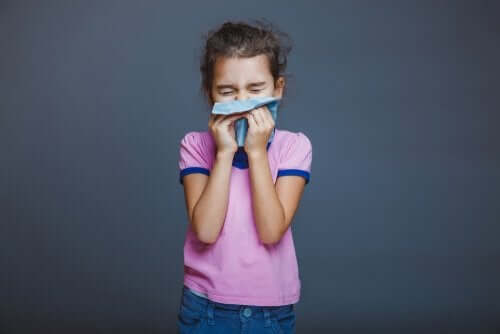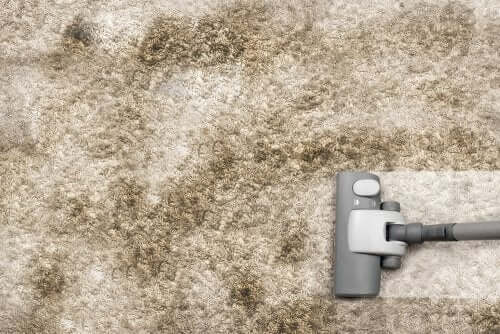7 Effective Home Remedies for Dust Mites

Dust mites are tiny bugs that live in your home, mainly in bedrooms. They’re not detectable at first sight. However, they can be responsible for certain diseases, such as allergies or scabies. That’s why it’s important to use home remedies for dust mites, so you can get rid of them.
Home remedies for dust mites
Dust mites belong to the Arachnida class and aren’t perceptible at first sight. They live in the dust and they’re usually on beds, pillows, clothes, blankets and mattresses. Since they act as allergens, they cause allergies to a large portion of the population. To get rid of them, we recommend that you use these seven home remedies for dust mites:
1. Control humidity
Humidity is one of the most important causes of house dust mites. So, it’s essential that humidity levels stay below 50%. Dehumidifiers and air conditioners are quite useful in these cases.
2. Take care of your mattress and pillows
The amount of dust mites that you can find on mattresses and pillows is astonishing. In fact, in some shops, you can find dust mites pillow covers. In case you can’t find these covers, you can always use the vacuum cleaner.

3. Ventilate your home, one of the best remedies for dust mites
Ventilating your home is essential, especially in the case of the bedrooms. Since dust mites are usually on mattresses, pillows and sheets, you should open your windows at least 30 minutes a day.
4. Remove dust regularly
It’s important that you don’t stir up dust rather than remove it. To avoid dust and dust mites in the air, you can use a wet cloth. Besides, it’s always better to use the vacuum cleaner instead of the broom.
More home remedies for dust mites
5. Washing sheets
You should change sheets at least once a week. And, you should wash them at 140ºF. If you use cold water, dust mites may stay alive.
6. Avoid carpets
Using carpets isn’t a good idea if you want to avoid dust mites. We recommend that you don’t use them. However, if you do, clean them frequently.
7. Chemical products
You can find anti-mite products in the supermarket. These are similar to regular insecticides, which you can use against all kinds of insects. The problem with this option is that these products don’t eliminate dead dust mites, which can still cause allergies. Therefore, we recommend that you clean everything after using anti-mite products.
Dust mites enjoy dirty places. That’s why you should clean everything and remove dust from curtains and furniture.
Liquid home remedies for dust mites
White vinegar
White vinegar has bactericidal and insecticidal properties. That’s why it’s one of the most common home remedies against microorganisms. For a correct use, you should combine it with water. Next, we’ll explain how:
Ingredients
- 1/2 cup water.
- 1/2 cup vinegar.
Preparation
- Combine both ingredients.
- Put the liquid in a spray bottle.

Directions for use
- Apply the product in the room, especially where dust mites usually are.
- Remove dust using a cloth.
- Repeat this twice a week.
Lavender and anise
Another home remedy that usually works against dust mites is the combination of lavender and anise. In addition to perfuming the house, it disinfects the areas in which dust mites live.
Ingredients
- 30 g lavender flowers.
- 1 cup water.
- 20 g anise.
- 1 tsp of cloves.
Preparation
- Put all the ingredients in a pan.
- Boil them.
- Once they’re boiling, turn off the heat.
- Strain and put the liquid in a spray bottle.
Directions for use
- Spray on the beds, sheets, couch, carpets and pillows.
- Repeat this twice a week.
In conclusion, these bugs might be a problem for the whole family, because they may cause allergies and other diseases. So, applying these home remedies for dust mites will be very helpful.
Dust mites are tiny bugs that live in your home, mainly in bedrooms. They’re not detectable at first sight. However, they can be responsible for certain diseases, such as allergies or scabies. That’s why it’s important to use home remedies for dust mites, so you can get rid of them.
Home remedies for dust mites
Dust mites belong to the Arachnida class and aren’t perceptible at first sight. They live in the dust and they’re usually on beds, pillows, clothes, blankets and mattresses. Since they act as allergens, they cause allergies to a large portion of the population. To get rid of them, we recommend that you use these seven home remedies for dust mites:
1. Control humidity
Humidity is one of the most important causes of house dust mites. So, it’s essential that humidity levels stay below 50%. Dehumidifiers and air conditioners are quite useful in these cases.
2. Take care of your mattress and pillows
The amount of dust mites that you can find on mattresses and pillows is astonishing. In fact, in some shops, you can find dust mites pillow covers. In case you can’t find these covers, you can always use the vacuum cleaner.

3. Ventilate your home, one of the best remedies for dust mites
Ventilating your home is essential, especially in the case of the bedrooms. Since dust mites are usually on mattresses, pillows and sheets, you should open your windows at least 30 minutes a day.
4. Remove dust regularly
It’s important that you don’t stir up dust rather than remove it. To avoid dust and dust mites in the air, you can use a wet cloth. Besides, it’s always better to use the vacuum cleaner instead of the broom.
More home remedies for dust mites
5. Washing sheets
You should change sheets at least once a week. And, you should wash them at 140ºF. If you use cold water, dust mites may stay alive.
6. Avoid carpets
Using carpets isn’t a good idea if you want to avoid dust mites. We recommend that you don’t use them. However, if you do, clean them frequently.
7. Chemical products
You can find anti-mite products in the supermarket. These are similar to regular insecticides, which you can use against all kinds of insects. The problem with this option is that these products don’t eliminate dead dust mites, which can still cause allergies. Therefore, we recommend that you clean everything after using anti-mite products.
Dust mites enjoy dirty places. That’s why you should clean everything and remove dust from curtains and furniture.
Liquid home remedies for dust mites
White vinegar
White vinegar has bactericidal and insecticidal properties. That’s why it’s one of the most common home remedies against microorganisms. For a correct use, you should combine it with water. Next, we’ll explain how:
Ingredients
- 1/2 cup water.
- 1/2 cup vinegar.
Preparation
- Combine both ingredients.
- Put the liquid in a spray bottle.

Directions for use
- Apply the product in the room, especially where dust mites usually are.
- Remove dust using a cloth.
- Repeat this twice a week.
Lavender and anise
Another home remedy that usually works against dust mites is the combination of lavender and anise. In addition to perfuming the house, it disinfects the areas in which dust mites live.
Ingredients
- 30 g lavender flowers.
- 1 cup water.
- 20 g anise.
- 1 tsp of cloves.
Preparation
- Put all the ingredients in a pan.
- Boil them.
- Once they’re boiling, turn off the heat.
- Strain and put the liquid in a spray bottle.
Directions for use
- Spray on the beds, sheets, couch, carpets and pillows.
- Repeat this twice a week.
In conclusion, these bugs might be a problem for the whole family, because they may cause allergies and other diseases. So, applying these home remedies for dust mites will be very helpful.
All cited sources were thoroughly reviewed by our team to ensure their quality, reliability, currency, and validity. The bibliography of this article was considered reliable and of academic or scientific accuracy.
- Arlian, L., Vyszenski-Moher, D. & Morgan, M. (2003). Mite and mite allergen removal during machine washing of laundry. The Journal of allergy and clinical immunology, 111(6), 1269–1273. Disponible en: https://pubmed.ncbi.nlm.nih.gov/12789228/
- Aggarwal, P. & Senthilkumaran, S. (2022). Dust Mite Allergy. StatPearls. Consultado el 29 de diciembre de 2019 Disponible en: https://www.ncbi.nlm.nih.gov/books/NBK560718/
- Harving, H., Korsgaard, J., & Dahl, R. (1994). House‐dust mite exposure reduction in specially designed, mechanically ventilated “healthy” homes. Allergy, 49(9), 713-718. Disponible en: https://pubmed.ncbi.nlm.nih.gov/7695059/
- Ong, K., Lewis, R., Dixit, A., et al. (2014). Inactivation of dust mites, dust mite allergen, and mold from carpet. Journal of occupational and environmental hygiene, 11(8), 519–527. Disponible en: https://pubmed.ncbi.nlm.nih.gov/24467247/
- Portnoy, J., Miller, J., Williams, P., et al. (2013). Environmental assessment and exposure control of dust mites: a practice parameter. Annals of Allergy, Asthma & Immunology, 111(6), 465-507. Disponible en: https://www.ncbi.nlm.nih.gov/pmc/articles/PMC5156485/
- Raulf, M., Bergmann, K., Kull, S., et al. (2015). Mites and other indoor allergens – from exposure to sensitization and treatment. Allergo journal international, 24(3), 68–80. Disponible en: https://www.ncbi.nlm.nih.gov/pmc/articles/PMC4479455/
- Sidenius, K., Hallas, T., Brygge, T., et al. (2002). House dust mites and their allergens at selected locations in the homes of house dust mite-allergic patients. Clinical and experimental allergy : journal of the British Society for Allergy and Clinical Immunology, 32(9), 1299–1304. Disponible en: https://pubmed.ncbi.nlm.nih.gov/12220467/
- Wilson, J. & Platts-Mills, T. (2018). Home Environmental Interventions for House Dust Mite. The journal of allergy and clinical immunology. In practice, 6(1), 1–7. Disponible en: https://pubmed.ncbi.nlm.nih.gov/12220467/
This text is provided for informational purposes only and does not replace consultation with a professional. If in doubt, consult your specialist.








